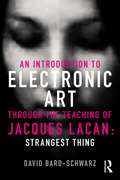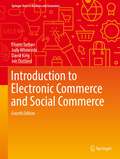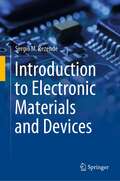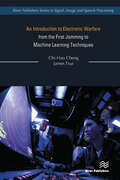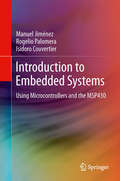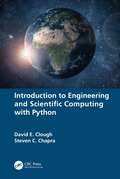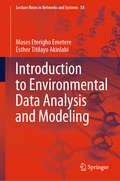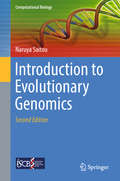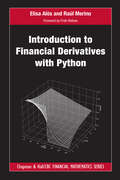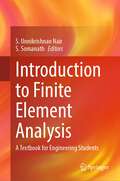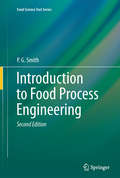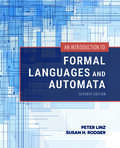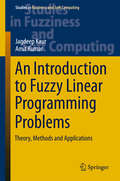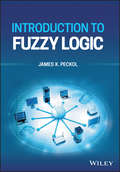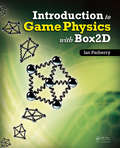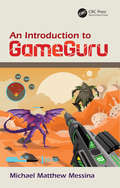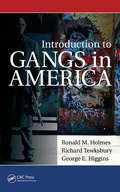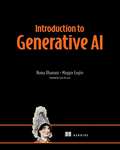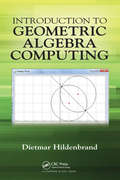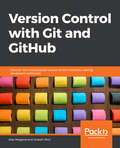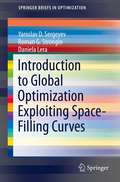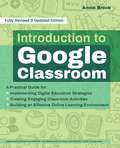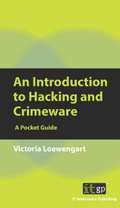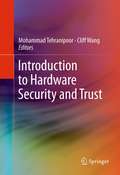- Table View
- List View
An Introduction to Electronic Art Through the Teaching of Jacques Lacan: Strangest Thing
by David Bard-SchwarzElectronic art offers endless opportunities for reflection and interpretation. Works can be interactive or entirely autonomous and the viewer's perception and reaction to them may be challenged by constantly transforming images. Whether the transformations are a product of the appearances or actions of a viewer in an installation space, or a product of a self-contained computer program, is a source of constant fascination. Some viewers may feel strange or unnerved by a work, while others may feel welcoming, humorous, and playful emotions. The art may also provoke a critical response to social, aesthetic, and political aspects of early twenty-first-century life. This book approaches electronic art through the teachings of Jacques Lacan, whose return to Freud has exerted a powerful and wide-ranging influence on psychoanalysis and critical theory in the twentieth century. David Bard-Schwarz draws on his experience with Lacanian psychoanalysis, music, and interactive and traditional arts in order to address aspects of the works the viewer may find difficult to understand. Dividing his approach over four thematic chapters—Bodies, Voices, Eyes, and Signifiers—Bard-Schwarz explores the links between works of new media and psychoanalysis (how we process what we see, hear, touch, imagine, and remember). This is a fascinating book for new media artists and critics, museum curators, psychologists, students in the fine arts, and those who are interested in digital technology and contemporary culture.
Introduction to Electronic Commerce and Social Commerce (Springer Texts in Business and Economics)
by Efraim Turban Judy Whiteside David King Jon OutlandThis is a complete update of the best-selling undergraduate textbook on Electronic Commerce (EC). New to this 4th Edition is the addition of material on Social Commerce (two chapters); a new tutorial on the major EC support technologies, including cloud computing, RFID, and EDI; ten new learning outcomes; and video exercises added to most chapters. Wherever appropriate, material on Social Commerce has been added to existing chapters. Supplementary material includes an Instructor’s Manual; Test Bank questions for each chapter; Powerpoint Lecture Notes; and a Companion Website that includes EC support technologies as well as online files.The book is organized into 12 chapters grouped into 6 parts. Part 1 is an Introduction to E-Commerce and E-Marketplaces. Part 2 focuses on EC Applications, while Part 3 looks at Emerging EC Platforms, with two new chapters on Social Commerce and Enterprise Social Networks. Part 4 examines EC Support Services, and Part 5 looks at E-Commerce Strategy and Implementation. Part 6 is a collection of online tutorials on Launching Online Businesses and EC Projects, with tutorials focusing on e-CRM; EC Technology; Business Intelligence, including Data-, Text-, and Web Mining; E-Collaboration; and Competition in Cyberspace.
Introduction to Electronic Materials and Devices
by Sergio M. RezendeThis textbook lays out the fundamentals of electronic materials and devices on a level that is accessible to undergraduate engineering students with no prior coursework in electromagnetism and modern physics. The initial chapters present the basic concepts of waves and quantum mechanics, emphasizing the underlying physical concepts behind the properties of materials and the basic principles of device operation. Subsequent chapters focus on the fundamentals of electrons in materials, covering basic physical properties and conduction mechanisms in semiconductors and their use in diodes, transistors, and integrated circuits. The book also deals with a broader range of modern topics, including magnetic, spintronic, and superconducting materials and devices, optoelectronic and photonic devices, as well as the light emitting diode, solar cells, and various types of lasers. The last chapter presents a variety of materials with specific novel applications, such as dielectric materials used in electronics and photonics, liquid crystals, and organic conductors used in video displays, and superconducting devices for quantum computing.Clearly written with compelling illustrations and chapter-end problems, Rezende’s Introduction to Electronic Materials and Devices is the ideal accompaniment to any undergraduate program in electrical and computer engineering. Adjacent students specializing in physics or materials science will also benefit from the timely and extensive discussion of the advanced devices, materials, and applications that round out this engaging and approachable textbook.
An Introduction to Electronic Warfare; from the First Jamming to Machine Learning Techniques
by Chi-Hao Cheng James TsuiSince its creation at the beginning of World II, radars have forever transformed the practice of modern warfare. The evolution of countermeasure conducted by electronic warfare systems against radars and radars’ corresponding counter countermeasures is an intriguing technical subject. This book provides a very accessible introduction to a broad range of radar and electronic warfare technologies. The subjects covered in this book range from early radar development to later technologies such as stealthy techniques, low probability of intercept radar, and machine learning. Historical events are used to illustrate the principles of electronic warfare and to help readers to apprehend contexts under which radars and corresponding electronic warfare techniques were developed.
Introduction to Embedded Systems
by Manuel Jiménez Rogelio Palomera Isidoro CouvertierThis textbook serves as an introduction to the subject of embedded systems design, using microcontrollers as core components It develops concepts from the ground up, covering the development of embedded systems technology, architectural and organizational aspects of controllers and systems, processor models, and peripheral devices. Since microprocessor-based embedded systems tightly blend hardware and software components in a single application, the book also introduces the subjects of data representation formats, data operations, and programming styles. The practical component of the book is tailored around the architecture of a widely used Texas Instrument's microcontroller, the MSP430 and a companion web site offers for download an experimenter's kit and lab manual, along with Powerpoint slides and solutions for instructors.
Introduction to Engineering and Scientific Computing with Python
by David E. Clough Steven C. ChapraAs more and more engineering departments and companies choose to use Python, this book provides an essential introduction to this open-source, free-to-use language. Expressly designed to support first-year engineering students, this book covers engineering and scientific calculations, Python basics, and structured programming. Based on extensive teaching experience, the text uses practical problem solving as a vehicle to teach Python as a programming language. By learning computing fundamentals in an engaging and hands-on manner, it enables the reader to apply engineering and scientific methods with Python, focusing this general language to the needs of engineers and the problems they are required to solve on a daily basis. Rather than inundating students with complex terminology, this book is designed with a leveling approach in mind, enabling students at all levels to gain experience and understanding of Python. It covers such topics as structured programming, graphics, matrix operations, algebraic equations, differential equations, and applied statistics. A comprehensive chapter on working with data brings this book to a close. This book is an essential guide to Python, which will be relevant to all engineers, particularly undergraduate students in their first year. It will also be of interest to professionals and graduate students looking to hone their programming skills, and apply Python to engineering and scientific contexts.
Introduction to Environmental Data Analysis and Modeling (Lecture Notes in Networks and Systems #58)
by Moses Eterigho Emetere Esther Titilayo AkinlabiThis book introduces numerical methods for processing datasets which may be of any form, illustrating adequately computational resolution of environmental alongside the use of open source libraries. This book solves the challenges of misrepresentation of datasets that are relevant directly or indirectly to the research. It illustrates new ways of screening datasets or images for maximum utilization. The adoption of various numerical methods in dataset treatment would certainly create a new scientific approach. The book enlightens researchers on how to analyse measurements to ensure 100% utilization. It introduces new ways of data treatment that are based on a sound mathematical and computational approach.
Introduction to Evolutionary Genomics (Computational Biology #Vol. 17)
by Naruya SaitouThis authoritative textbook/reference presents a comprehensive introduction to the field of evolutionary genomics. The opening chapters describe the fundamental concepts in molecular biology and genome evolution for readers without any prior background in this area. This is followed by a detailed examination of genome evolution in various different groups of organisms. The text then concludes with a review of practical methods essential to researchers in the field.This updated and revised new edition also features historical perspectives on contributions to evolutionary genomics from related fields such as molecular evolution, genetics, and numerical taxonomy.Topics and features: introduces the basics of molecular biology, covering protein structure and diversity, as well as DNA replication, transcription, and translation; examines the phylogenetic relationships of DNA sequences, and the processes of mutation, neutral evolution, and natural selection; presents a brief evolutionary history of life, surveying the key features of the genomes of prokaryotes, eukaryotes, viruses and phages, vertebrates, and humans; reviews the various biological “omic” databases, and discusses the analysis of homologous nucleotide and amino acid sequences; provides an overview of the experimental sequencing of genomes and transcriptomes, and the construction of phylogenetic trees; describes methods for estimating of evolutionary distances, and performing studies of population genetics; supplies additional supporting material at an associated website.Serving as an indispensable textbook for graduate and advanced undergraduate courses on evolutionary genomics, this accessible overview will also prove invaluable to researchers from both computer science and the biological sciences seeking a primer on the field.
Introduction to Excel and SPSS: A Stepwise Approach to Statistical Software
by Susan D. Croll Michelle L. FowlerIntroduction to Excel and SPSS: A Stepwise Approach to Statistical Software by Susan D. Croll and Michelle L. Fowler
Introduction to Financial Derivatives with Python (Chapman and Hall/CRC Financial Mathematics Series)
by Elisa Alòs Raúl MerinoIntroduction to Financial Derivatives with Python is an ideal textbook for an undergraduate course on derivatives, whether on a finance, economics, or financial mathematics programme. As well as covering all of the essential topics one would expect to be covered, the book also includes the basis of the numerical techniques most used in the financial industry, and their implementation in Python. Features Connected to a Github repository with the codes in the book. The repository can be accessed at https://bit.ly/3bllnuf Suitable for undergraduate students, as well as anyone who wants a gentle introduction to the principles of quantitative finance No pre-requisites required for programming or advanced mathematics beyond basic calculus
Introduction to Finite Element Analysis: A Textbook for Engineering Students
by S. Unnikrishnan Nair S. SomanathThis textbook covers the basic concepts and applications of finite element analysis. It is specifically aimed at introducing this advanced topic to undergraduate-level engineering students and practicing engineers in a lucid manner. It also introduces a structural and heat transfer analysis software FEASTSMT which has wide applications in civil, mechanical, nuclear and automobile engineering domains. This software has been developed by generations of scientists and engineers of Vikram Sarabhai Space Centre and Indian Space Research Organisation. Supported with many illustrative examples, the textbook covers the classical methods of estimating solutions of mathematical models. The book is written in an easy-to-understand manner. This textbook also contains numeral exercise problems to aid self-learning of the students. The solutions to these problems are demonstrated using finite element software. Furthermore, the textbook contains several tutorials and associated online resources on usage of the FEASTSMT software. Given the contents, this textbook is highly useful for the undergraduate students of various disciplines of engineering. It is also a good reference book for the practicing engineers.
Introduction to Food Process Engineering
by P. G. SmithThis is a new book on food process engineering which treats the principles of processing in a scientifically rigorous yet concise manner, and which can be used as a lead in to more specialized texts for higher study. It is equally relevant to those in the food industry who desire a greater understanding of the principles of the food processes with which they work. This text is written from a quantitative and mathematical perspective and is not simply a descriptive treatment of food processing. The aim is to give readers the confidence to use mathematical and quantitative analyses of food processes and most importantly there are a large number of worked examples and problems with solutions. The mathematics necessary to read this book is limited to elementary differential and integral calculus and the simplest kind of differential equation.
An Introduction to Formal Languages and Automata
by Peter Linz Susan H. RodgerAn Introduction to Formal Languages and Automata, Seventh Edition is designed for an introductory course on formal languages, automata, compatibility, and related matters forming what is known as the theory of computation.
An Introduction to Fuzzy Linear Programming Problems: Theory, Methods and Applications (Studies in Fuzziness and Soft Computing #340)
by Amit Kumar Jagdeep KaurThe book presents a snapshot of the state of the art in the field of fully fuzzy linear programming. The main focus is on showing current methods for finding the fuzzy optimal solution of fully fuzzy linear programming problems in which all the parameters and decision variables are represented by non-negative fuzzy numbers. It presents new methods developed by the authors, as well as existing methods developed by others, and their application to real-world problems, including fuzzy transportation problems. Moreover, it compares the outcomes of the different methods and discusses their advantages/disadvantages. As the first work to collect at one place the most important methods for solving fuzzy linear programming problems, the book represents a useful reference guide for students and researchers, providing them with the necessary theoretical and practical knowledge to deal with linear programming problems under uncertainty.
Introduction to Fuzzy Logic
by James K. PeckolINTRODUCTION TO FUZZY LOGIC Learn more about the history, foundations, and applications of fuzzy logic in this comprehensive resource by an academic leader Introduction to Fuzzy Logic delivers a high-level but accessible introduction to the rapidly growing and evolving field of fuzzy logic and its applications. Distinguished engineer, academic, and author James K. Peckol covers a wide variety of practical topics, including the differences between crisp and fuzzy logic, the people and professionals who find fuzzy logic useful, and the advantages of using fuzzy logic. While the book assumes a solid foundation in embedded systems, including basic logic design, and C/C++ programming, it is written in a practical and easy-to-read style that engages the reader and assists in learning and retention. The author includes introductions of threshold and perceptron logic to further enhance the applicability of the material contained within. After introducing readers to the topic with a brief description of the history and development of the field, Introduction to Fuzzy Logic goes on to discuss a wide variety of foundational and advanced topics, like: A review of Boolean algebra, including logic minimization with algebraic means and Karnaugh maps A discussion of crisp sets, including classic set membership, set theory and operations, and basic classical crisp set properties A discussion of fuzzy sets, including the foundations of fuzzy set logic, set membership functions, and fuzzy set properties An analysis of fuzzy inference and approximate reasoning, along with the concepts of containment and entailment and relations between fuzzy subsets Perfect for mid-level and upper-level undergraduate and graduate students in electrical, mechanical, and computer engineering courses, Introduction to Fuzzy Logic covers topics included in many artificial intelligence, computational intelligence, and soft computing courses. Math students and professionals in a wide variety of fields will also significantly benefit from the material covered in this book.
Introduction to Game Physics with Box2D
by Ian ParberryWritten by a pioneer of game development in academia, Introduction to Game Physics with Box2D covers the theory and practice of 2D game physics in a relaxed and entertaining yet instructional style. It offers a cohesive treatment of the topics and code involved in programming the physics for 2D video games. Focusing on writing elementary game physics code, the first half of the book helps you grasp the challenges of programming game physics from scratch, without libraries or outside help. It examines the mathematical foundation of game physics and illustrates how it is applied in practice through coding examples. The second half of the book shows you how to use Box2D, a popular open source 2D game physics engine. A companion website provides supplementary material, including source code and videos. This book helps you become a capable 2D game physics programmer through its presentation of both the theory and applications of 2D game physics. After reading the book and experimenting with the code samples, you will understand the basics of 2D game physics and know how to use Box2D to make a 2D physics-based game.
An Introduction to GameGuru
by Michael Matthew MessinaGame-Guru is an entry-level engine designed to be easy to use as well as being extremely accessible for the user. This book gives users the information needed to access the full depth of features available in the program. Details on how to perform more complex tasks are not found easily anywhere else or in any of the Game-Guru documentation. This book will cover all of the common topics including building levels, coding, AI and more. Key Features The only book the fully covers the Game-Guru engine Includes robust documentation to perform complex tasks that are not outlined anywhere else Includes level building, coding, AI and more Included are scripts and demo maps for readers to learn from An Introduction to Game Guru is the ultimate start-to-finish guide Michael is the Chief Linux Systems Engineer for a Fortune 500 company Includes many custom assets for your own project!
Introduction to Gangs in America
by Ronald M. Holmes Richard Tewksbury George HigginsGangs have long been a social and criminal threat to society. Introduction to Gangs in America explains how gangs are addressed as a criminal justice and public policy problem, providing a student-friendly, easily accessible, concise overview of the role, place, structure, and activities of gangs in American society. The book describes what gangs a
Introduction to Generative AI
by Numa DhamaniGenerative AI tools like ChatGPT are amazing—but how will their use impact our society? This book introduces the world-transforming technology and the strategies you need to use generative AI safely and effectively.Introduction to Generative AI gives you the hows-and-whys of generative AI in accessible language. In this easy-to-read introduction, you&’ll learn: How large language models (LLMs) work How to integrate generative AI into your personal and professional workflows Balancing innovation and responsibility The social, legal, and policy landscape around generative AI Societal impacts of generative AI Where AI is going Anyone who uses ChatGPT for even a few minutes can tell that it&’s truly different from other chatbots or question-and-answer tools. Introduction to Generative AI guides you from that first eye-opening interaction to how these powerful tools can transform your personal and professional life. In it, you&’ll get no-nonsense guidance on generative AI fundamentals to help you understand what these models are (and aren&’t) capable of, and how you can use them to your greatest advantage. Foreword by Sahar Massachi. About the technology Generative AI tools like ChatGPT, Bing, and Bard have permanently transformed the way we work, learn, and communicate. This delightful book shows you exactly how Generative AI works in plain, jargon-free English, along with the insights you&’ll need to use it safely and effectively. About the book Introduction to Generative AI guides you through benefits, risks, and limitations of Generative AI technology. You&’ll discover how AI models learn and think, explore best practices for creating text and graphics, and consider the impact of AI on society, the economy, and the law. Along the way, you&’ll practice strategies for getting accurate responses and even understand how to handle misuse and security threats. What's inside How large language models work Integrate Generative AI into your daily work Balance innovation and responsibility About the reader For anyone interested in Generative AI. No technical experience required. About the author Numa Dhamani is a natural language processing expert working at the intersection of technology and society. Maggie Engler is an engineer and researcher currently working on safety for large language models. The technical editor on this book was Maris Sekar. Table of Contents 1 Large language models: The power of AI Evolution of natural language processing 2 Training large language models 3 Data privacy and safety with LLMs 4 The evolution of created content 5 Misuse and adversarial attacks 6 Accelerating productivity: Machine-augmented work 7 Making social connections with chatbots 8 What&’s next for AI and LLMs 9 Broadening the horizon: Exploratory topics in AI
Introduction to Geometric Algebra Computing: Computing with Circles and Lines (Computer Vision Series)
by Dietmar HildenbrandFrom the Foreword: "Dietmar Hildenbrand's new book, Introduction to Geometric Algebra Computing, in my view, fills an important gap in Clifford's geometric algebra literature…I can only congratulate the author for the daring simplicity of his novel educational approach taken in this book, consequently combined with hands on computer based exploration. Without noticing, the active reader will thus educate himself in elementary geometric algebra algorithm development, geometrically intuitive, highly comprehensible, and fully optimized." --Eckhard Hitzer, International Christian University, Tokyo, Japan Geometric Algebra is a very powerful mathematical system for an easy and intuitive treatment of geometry, but the community working with it is still very small. The main goal of this book is to close this gap with an introduction to Geometric Algebra from an engineering/computing perspective. This book is intended to give a rapid introduction to computing with Geometric Algebra and its power for geometric modeling. From the geometric objects point of view, it focuses on the most basic ones, namely points, lines and circles. This algebra is called Compass Ruler Algebra, since it is comparable to working with a compass and ruler. The book explores how to compute with these geometric objects, and their geometric operations and transformations, in a very intuitive way. The book follows a top-down approach, and while it focuses on 2D, it is also easily expandable to 3D computations. Algebra in engineering applications such as computer graphics, computer vision and robotics are also covered.
Introduction to Git and GitHub
by Alex Magana Joseph MuliIf you want to migrate from other version control tools or want to learn more about Git, you will find this course useful and interesting. Prior experience in coding or familiarity with using the bash command line interface, will enable you to easily grasp concepts.
Introduction to Global Optimization Exploiting Space-Filling Curves
by Yaroslav D. Sergeyev Daniela Lera Roman G. StronginIntroduction to Global Optimization Exploiting Space-Filling Curves provides an overview of classical and new results pertaining to the usage of space-filling curves in global optimization. The authors look at a family of derivative-free numerical algorithms applying space-filling curves to reduce the dimensionality of the global optimization problem; along with a number of unconventional ideas, such as adaptive strategies for estimating Lipschitz constant, balancing global and local information to accelerate the search. Convergence conditions of the described algorithms are studied in depth and theoretical considerations are illustrated through numerical examples. This work also contains a code for implementing space-filling curves that can be used for constructing new global optimization algorithms. Basic ideas from this text can be applied to a number of problems including problems with multiextremal and partially defined constraints and non-redundant parallel computations can be organized. Professors, students, researchers, engineers, and other professionals in the fields of pure mathematics, nonlinear sciences studying fractals, operations research, management science, industrial and applied mathematics, computer science, engineering, economics, and the environmental sciences will find this title useful .
Introduction to Google Classroom
by Annie BrockLearn to take your classroom curriculum digital using Google Classroom&’s unique file sharing features. Introduction to Google Classroom will help teachers of all grade levels master the basics of communication and education using the Google Classroom file sharing service. Learn how to connect with students, control access to lessons, distribute assignments, and update your class calendar. Google Classroom newbie? No worries! Experienced educator and author Annie Brock takes readers step-by-step through the most common Google Classroom features and terminology. Packed with tips, tricks, troubleshooting, helpful screenshots, and activity ideas to keep students of all ages engaged, this book is indispensable as the future of teaching continues to evolve.
An Introduction to Hacking and Crimeware
by Victoria LoewengartDefend your business, protect your livelihood, safeguard your future. Cybercrime is on the rise. Unchecked, it could destroy the entire global cyber infrastructure and wipe out many businesses. We need to defend ourselves against it, and we must fight back. Toolkits to create malware are now readily available to anyone wishing to defraud and do damage. For your business to survive and thrive, it is vital to stay informed about the threats and the risks, and arm yourself against them. Know your enemyAn Introduction to Hacking & Crimeware is a comprehensive guide to the most recent and the more serious threats. Knowing about these threats will help you understand how to ensure that your computer systems are protected and that your business is safe, enabling you to focus on your core activities. Fighting backIn this pocket guide, the author:defines exactly what crimeware is _ both intentional and unintentional _ and gives specific, up-to-date examples to help you identify the risks and protect your businessexplores the increasing use of COTS tools as hacking tools, exposing the enemy_s tactics gives practical suggestions as to how you can fight backprovides a valuable list of up-to-date, authoritative sources of information, so you can stay abreast of new developments and safeguard your business.
Introduction to Hardware Security and Trust
by Cliff Wang Mohammad TehranipoorThis book provides the foundations for understanding hardware security and trust, which have become major concerns for national security over the past decade. Coverage includes security and trust issues in all types of electronic devices and systems such as ASICs, COTS, FPGAs, microprocessors/DSPs, and embedded systems. This serves as an invaluable reference to the state-of-the-art research that is of critical significance to the security of, and trust in, modern society's microelectronic-supported infrastructures.
